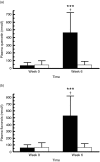Effects of a quercetin-rich onion skin extract on 24 h ambulatory blood pressure and endothelial function in overweight-to-obese patients with (pre-)hypertension: a randomised double-blinded placebo-controlled cross-over trial
- PMID: 26328470
- PMCID: PMC4594049
- DOI: 10.1017/S0007114515002950
Effects of a quercetin-rich onion skin extract on 24 h ambulatory blood pressure and endothelial function in overweight-to-obese patients with (pre-)hypertension: a randomised double-blinded placebo-controlled cross-over trial
Abstract
The polyphenol quercetin may prevent CVD due to its antihypertensive and vasorelaxant properties. We investigated the effects of quercetin after regular intake on blood pressure (BP) in overweight-to-obese patients with pre-hypertension and stage I hypertension. In addition, the potential mechanisms responsible for the hypothesised effect of quercetin on BP were explored. Subjects (n 70) were randomised to receive 162 mg/d quercetin from onion skin extract powder or placebo in a double-blinded, placebo-controlled cross-over trial with 6-week treatment periods separated by a 6-week washout period. Before and after the intervention, ambulatory blood pressure (ABP) and office BP were measured; urine and blood samples were collected; and endothelial function was measured by EndoPAT technology. In the total group, quercetin did not significantly affect 24 h ABP parameters and office BP. In the subgroup of hypertensives, quercetin decreased 24 h systolic BP by -3·6 mmHg (P=0·022) when compared with placebo (mean treatment difference, -3·9 mmHg; P=0·049). In addition, quercetin significantly decreased day-time and night-time systolic BP in hypertensives, but without a significant effect in inter-group comparison. In the total group and also in the subgroup of hypertensives, vasoactive biomarkers including endothelin-1, soluble endothelial-derived adhesion molecules, asymmetric dimethylarginine, angiotensin-converting enzyme activity, endothelial function, parameters of oxidation, inflammation, lipid and glucose metabolism were not affected by quercetin. In conclusion, supplementation with 162 mg/d quercetin from onion skin extract lowers ABP in patients with hypertension, suggesting a cardioprotective effect of quercetin. The mechanisms responsible for the BP-lowering effect remain unclear.
Keywords: ABP ambulatory blood pressure; ACE angiotensin-converting enzyme; ADMA asymmetric dimethylarginine; BP blood pressure; Blood pressure; Cardiovascular diseases; DBP diastolic blood pressure; Endothelial function; Hypertension; IsoP isoprostanes; MAP mean arterial pressure; PAT peripheral arterial tonometry; Quercetin; RHI reactive hyperaemia index; SBP systolic blood pressure; oxLDL oxidised LDL; sICAM-1 soluble intercellular adhesion molecule 1; sVCAM-1 soluble vascular cell adhesion molecule 1.
Figures


Similar articles
-
Acute intake of quercetin from onion skin extract does not influence postprandial blood pressure and endothelial function in overweight-to-obese adults with hypertension: a randomized, double-blind, placebo-controlled, crossover trial.Eur J Nutr. 2017 Apr;56(3):1347-1357. doi: 10.1007/s00394-016-1185-1. Epub 2016 Feb 29. Eur J Nutr. 2017. PMID: 26924303 Clinical Trial.
-
Quercetin reduces systolic blood pressure and plasma oxidised low-density lipoprotein concentrations in overweight subjects with a high-cardiovascular disease risk phenotype: a double-blinded, placebo-controlled cross-over study.Br J Nutr. 2009 Oct;102(7):1065-74. doi: 10.1017/S0007114509359127. Epub 2009 Apr 30. Br J Nutr. 2009. PMID: 19402938 Clinical Trial.
-
No effects of quercetin from onion skin extract on serum leptin and adiponectin concentrations in overweight-to-obese patients with (pre-)hypertension: a randomized double-blinded, placebo-controlled crossover trial.Eur J Nutr. 2017 Oct;56(7):2265-2275. doi: 10.1007/s00394-016-1267-0. Epub 2016 Jul 16. Eur J Nutr. 2017. PMID: 27423432 Clinical Trial.
-
Effect of quercetin supplementation on plasma lipid profiles, blood pressure, and glucose levels: a systematic review and meta-analysis.Nutr Rev. 2020 Aug 1;78(8):615-626. doi: 10.1093/nutrit/nuz071. Nutr Rev. 2020. PMID: 31940027
-
The Effects of Quercetin Supplementation on Blood Pressures and Endothelial Function Among Patients with Metabolic Syndrome and Related Disorders: A Systematic Review and Meta-analysis of Randomized Controlled Trials.Curr Pharm Des. 2019;25(12):1372-1384. doi: 10.2174/1381612825666190513095352. Curr Pharm Des. 2019. PMID: 31092175
Cited by
-
Onion and Apple Functional Ingredients Intake Improves Antioxidant and Inflammatory Status and Vascular Injury in Obese Zucker Rats.Antioxidants (Basel). 2022 Sep 29;11(10):1953. doi: 10.3390/antiox11101953. Antioxidants (Basel). 2022. PMID: 36290676 Free PMC article.
-
Genetic polymorphisms associated with reactive oxygen species and blood pressure regulation.Pharmacogenomics J. 2019 Aug;19(4):315-336. doi: 10.1038/s41397-019-0082-4. Epub 2019 Feb 6. Pharmacogenomics J. 2019. PMID: 30723314 Free PMC article. Review.
-
Phytochemicals and In Vitro Bioactivities of Aqueous Ethanolic Extracts from Common Vegetables in Thai Food.Plants (Basel). 2021 Jul 29;10(8):1563. doi: 10.3390/plants10081563. Plants (Basel). 2021. PMID: 34451608 Free PMC article.
-
The Effects of Quercetin on Vascular Endothelium, Inflammation, Cardiovascular Disease and Lipid Metabolism-A Review.Nutrients. 2025 May 3;17(9):1579. doi: 10.3390/nu17091579. Nutrients. 2025. PMID: 40362888 Free PMC article. Review.
-
The Anti-Diabetic Effects of Medicinal Plants Belonging to the Liliaceae Family: Potential Alpha Glucosidase Inhibitors.Drug Des Devel Ther. 2024 Aug 13;18:3595-3616. doi: 10.2147/DDDT.S464100. eCollection 2024. Drug Des Devel Ther. 2024. PMID: 39156483 Free PMC article. Review.
References
-
- Crozier A, Jaganath IB & Clifford MN (2009) Dietary phenolics: chemistry, bioavailability and effects on health. Nat Prod Rep 26, 1001–1043. - PubMed
-
- Erdman JW Jr, Balentine D, Arab L, et al. (2007) Flavonoids and Heart Health: Proceedings of the ILSI North America Flavonoids Workshop, May 31-June 1, 2005, Washington, DC. J Nutr 137, 718S–737S. - PubMed
-
- Scalbert A & Williamson G (2000) Dietary intake and bioavailability of polyphenols. J Nutr 130, 2073S–2085S. - PubMed
-
- Wang X, Ouyang YY, Liu J, et al. (2013) Flavonoid intake and risk of CVD: a systematic review and meta-analysis of prospective cohort studies. Br J Nutr 111, 1–11. - PubMed
-
- Hubbard GP, Wolffram S, Lovegrove JA, et al. (2004) Ingestion of quercetin inhibits platelet aggregation and essential components of the collagen-stimulated platelet activation pathway in humans. J Thromb Haemost 2, 2138–2145. - PubMed
Publication types
MeSH terms
Substances
LinkOut - more resources
Full Text Sources
Other Literature Sources
Medical
Miscellaneous

